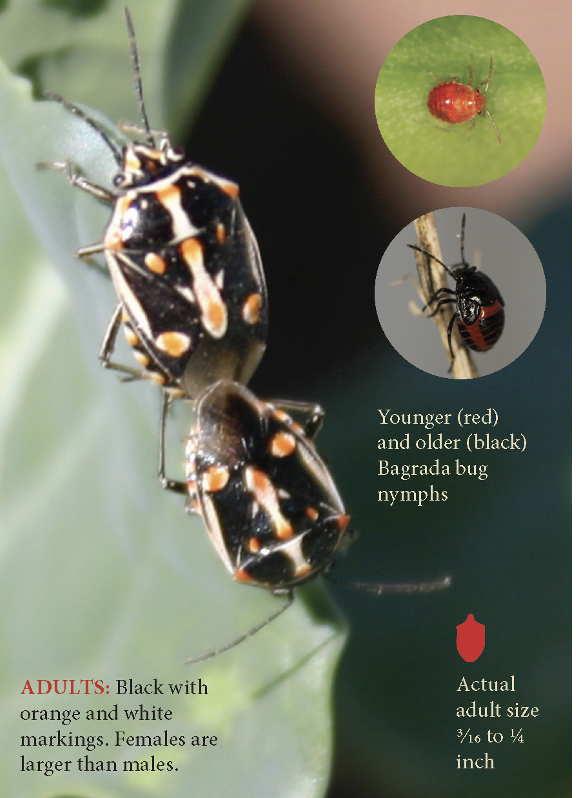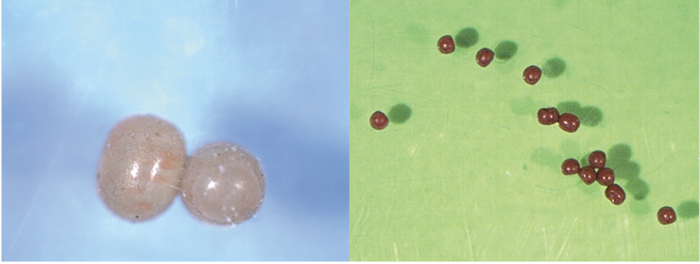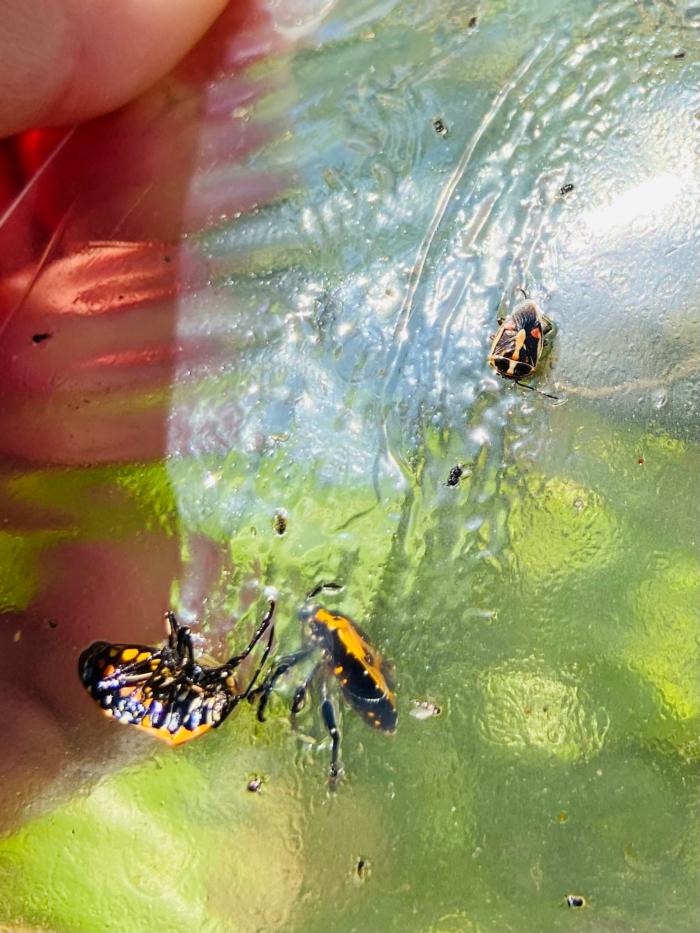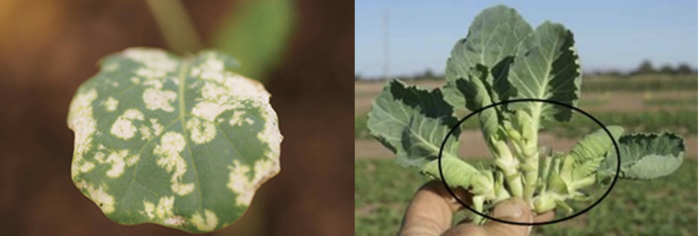Bagrada bug
The Bagrada bug, Bagrada hilaris, is a small invasive stink bug originating from East Africa and is considered a major pest in Africa, Iran, Iraq, Pakistan, Italy, Sri Lanka and India. It was first reported in southern California in 2008 and has slowly spread in agricultural areas of California. Bagrada bug was reported in Marin County in 2015 and was reported for the first time in Lake, Mendocino, and Sonoma counties in 2021. Due to this, it is an important insect to become familiar with especially if you work with commercially grown vegetable crops, work for a nursery or have a home garden. This small stink bug has been responsible for causing severe crop, nursery and landscape damage resulting in economic losses.
Identification
Bagrada bugs are small for stink bugs ranging from 3/16 to ¼ inch in length (5 to 7 mm). Adults have a shield-shaped body and are predominantly black with white and orange markings (Figure 1). Males are smaller than females. A female can lay 10 eggs a day and as many as 150 over 2 to 3 weeks. The eggs are barrel shaped and laid singly or in small groups on the underside of leaves, stems or in the soil directly under the plants. Eggs are a creamy-white color when they are newly laid but turn reddish color over time (Figure 2). Early nymphs are wingless and bright orange to red in color and progress to become a combination of black and red in later immature stages (Figure 1). Only adults have wings to fly and can reproduce. The bagrada bug’s life cycle takes 3 to 4 weeks to complete resulting in populations to build up quickly from several generations occurring each year. Adults overwinter in leaf litter and topsoil when temperatures become cool and reemerge the following season.

Figure 1. Bagrada bug adults are small (3/16 to ¼ inch) predominantly black with white and orange markings. Males are slightly smaller than females. Early immature stages are reddish in color and progress to become a darker red with black markings in later immature stages. (Used by permission from the University of California Statewide IPM Program’s Bagrada Bug Pest Alert, http://ipm.ucanr.edu/pestalert/pabagradabug.html, photo credit Eric T. Natwick & Surendra K. Dara)

Figure 2. Barrel shaped Bagrada bug eggs turn from a creamy white color (Left) to a reddish color (Right) before they are about to hatch. Photo credit: courtesy of North Central IPM Center https://www.ncipmc.org/projects/pest-alerts1/bagrada-bug-bagrada-hilaris-burmeister/
Mistaken identity
Bagrada bugs look very similar to, and are often confused with, another stink bug species that is found in California row crops: the Harlequin bug (Figure 3). They both have black and red markings, but the most noticeable difference is their size. Harlequin bugs are considerably larger at about 3/8 inch in length (8 to 11 mm). In addition, the immature stages of bagrada bug have been confused with the beneficial ladybird beetle due to being similar in size and coloration.

Figure 3. Bagrada bug (upper right) and two Harlequin bugs (lower left) on a sticky trap with a thumb for size reference to show relative size differences between the two species. Photo credit: Cindy Kron, UCCE IPM Advisor
Plant hosts
Bagrada bugs feed on a range of crops and non-crop hosts but prefer plants in the mustard family. They can cause damage to broccoli, cabbage, cauliflower, arugula, collards, kale, radish, and related crops. They have also been documented on strawberries, melons, sunflower, potatoes, peppers, legumes, wheat, corn, etc. They will also feed on weeds such as wild mustard, pepperweed, London rocket, field bindweed, lambsquarters, purple nutsedge, perennial sowthistle and shepherd’s purse and ornamentals such as candytuft, stock, rockcress, wallflower, nasturtiums, and sweet alyssum. Bagrada bugs can often be seen in large numbers feeding on their host plants in late Summer and Fall when multiple generations have occurred and food sources are scarce. It is not uncommon to see all life stages present on the same plant in the later season. Bagrada bug feeding damage is most notable when it kills small plants and seedlings, but it can also cause leaves to have star-shaped white spots, leaves to wilt and die, stunting of growth, blind terminals to form and forked or multiple heads to develop in cabbage, cauliflower, and broccoli (Figure 4). Organic row crops suffer the heaviest damage due to currently available organic products not offering full control.

Figure 4. Star-shaped white spot damage on leaves (Left) and multiple head development (Right) caused by Bagrada bug feeding. Photo credit: (Left) courtesy of North Central IPM Center https://www.ncipmc.org/projects/pest-alerts1/bagrada-bug-bagrada-hilaris-burmeister/ (Right) J. Palumbo
Prevention
Crops most at risk are those located near grassy areas, weedy areas especially those with mustard family weeds, river bottoms and residential areas with home gardens or harboring other known bagrada bug host plants. Removal of weedy mustard plants in and around commercial row crop fields and home gardens can help reduce the number of bagrada bugs in the general area. Inspect vegetable starts before planting. Since bagrada bugs can hide in the top layer of soil and sides of the vegetable start containers, inspect the vegetable starts just after watering which is likely to draw the insects out if present. Monitor plants for damage in the field or garden. When it is sunny and temperatures are above 75 °F, shake or tap plants over a large tray or sheet of paper to dislodge any insects present.
Control options
Control recommendations can be found on UCIPM’s website:
Gardens and Landscapes: http://ipm.ucanr.edu/PMG/PESTNOTES/pn74166.html
Commercial crop management: https://www2.ipm.ucanr.edu/Invasive-and-Exotic-Pests/Bagrada-bug/Bagrada-Bug-in-Agriculture/
Nursery management: http://ipm.ucanr.edu/PDF/PMG/bagradabug.pdf
Report any sightings
If you find a stink bug in your county that fits the markings and size descriptions above, collect it in a sealed container and document the location and date when found before taking it to your local county agricultural commissioner or UC Cooperative Extension office. Together with your help, we can help keep this invasive stink bug out of our counties.

